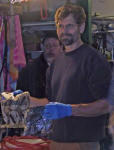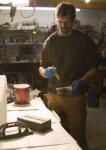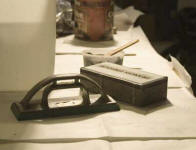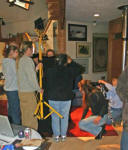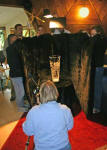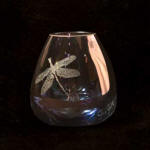Pacific Northwest Sand CarversWorkshop - October 23, 2005Compiled by: Irene D'Aloisio
Thanks to Shane and Macy for hosting and sharing yesterday. It was a really great day. A typical Northwest autumn day, gray and gold. Foggy and misty with the fall accents in gold leaves. There really are some days here where the rain can be nice. A warm fire, coffee, cookies, chips and lots of interesting chatter made the day just about perfect. Shane and Macy live away from the city so it was quiet except for the roar of the compressor and the whooshing of the grit coming through the hose. Wonderful sounds to us carvers!
We started off the day with hugging and catching up and meeting a couple of new folks. It always seems like itís been years between our visits we spend so much time talking. Of course, a lot of the talk is about things weíve seen or questions we have about processes and ideas. That just starts the ball rolling. There are always four or five conversations going at once. Itís a happy noise, motivating and warm. And, of course, they are always told more than once because someone across the room says ďGee, what were you guys talking about over there?Ē
We started the day with Shaneís showing us how he uses epoxy grout on his pavers. We got lots of tips and learned when it might be a good time to use paint, as opposed to using grout. Turns out that grout is extremely hard.
After that we broke off into two groups. One group moved to the table to discuss photography equipment and a little of the process. Mary Anne Lauby had just taken a workshop on photography so she was able to share some of her notes and run through them for us. It was a good list of things that one should know about a camera right now. It was really helpful because some of us have promised ourselves we would go through the instruction manuals page by page and learn everything in them. Of course thatís impossible! And who really does that anyway? The list gave us a summary of where to start. We also discussed a little about some of the processes in Photoshop and how to change a digital photo if the picture isnít perfect. Discussion encompassed file formats, specifically how they compared to the RAW format. Some of these discussions were at a high level and may be continued as an advanced process sometime later. One of the best tipsÖ.remember that saving a jpg compresses the file every time. So each time it is saved, there is a loss of more and more of the original photo. Be sure to save the picture coming out of the camera and make a copy to work on. That way the original will be available when needed.
The other group began a shading lesson. Macy donated her time and some wonderful Fremont glass (flashed!) to show us how to shade. She used her own pattern of grapes and cut resists for us on the plotter. And, she uses a pressure pot to shade!! When it came time to blast, it was like having a private instructor, with Macy looking over our shoulder and giving us hints and tips. We have several very natural shaders in our groupÖincluding some spouses who donít generally blast.
Macy has recently completed some very beautiful windows for a church in the Seattle area. She showed us pictures that made us drool. Maybe we can convince her to post pictures for the rest of the group.
Pictured above: How many sandcarvers does it take to get a photo? Apparently, all of us. Debz carved vase, Greg's small piece, Russ' wine bottle.
Next, it was time to practice taking pictures. Several folks brought samples of work they wanted or needed pictures of. Greg brought a beautiful iridescent, mirrored glass vase carved with a dragonfly. Even though itís small, itís still a difficult project to photograph and we wondered if there was any way at all to do its elegant look justice. He tried a black background and a white one, but we finally decided it needs to be raised up off the surface so the fabric is not reflected in the bottom of the vase. There wasnít time to do that there so heíll work on it some more before our next session in mid-November at Debz and VJís.
VJ brought out Debzís very tall and very gorgeous sea vase. The work this group does! Itís incredible that there is so much talent in one little area. We took lots of photographs and examined them all, coming up with several good shots.
All in all, we were able to learn by watching and doing. The examples we worked on gave us all the ability to go home and try this ourselves. Of course, we are going to need to call four or five friends over to help. Thatís how many sandcarvers it takes to take one photograph, we decided.
We had some great samples to photograph, and some interesting tools for the session. Each of us brought something we thought we could use in aiding our sessions: lights, foam core, plush fabric, white muslin, tripods, cameras. We didnít have stands so we just used our hands to hold the fabric up. The Home Depot halogen lights worked great. However, we noticed a little bit of orange in the output and we wondered if the color would be more pure if we took the UV filters out of the lights. Some of us will try that before our next session.
And, as usual, lots of ideas get generated. Irene and Jim discussed the possibility of using the halogen lights instead of a black light for developing photoresist. What about using it with a vacuum frame as itís the light and integrator that is expensive. Nowadays, you can get a frame and a pump practically for free since new plate technology is making them obsolete. Jim said he might try some tests.
All in all, it was an experimental, hands-on session for everyone. Just a try-it-and-see-what-you-learn kind of thing. It was great because itís something weíve all been wanting to do. Some of us had difficulty finding time to do it at home, others didnít know where to start, and still others needed equipment. By bringing everyone and everything together, we were able to satisfy everyone's needs and get us all off to a good start. And prove we didnít need hundreds or thousands of dollars of special equipment to take a good photo of our glass without reflections.
Weíre all going to experiment over the next several weeks. Then weíll meet at Debz and VJís to review our findings, and do a little more work on photographing installed items. Debz will also give us a little help on shading too. She uses a siphon pot for her work rather than a pressure pot.
We got to meet Russ (Meatshake) and Martha and see their cold cathode lighting setup. Neat! Little does he know how interested we are in lighting. Thanks for sharing, Russ and Martha.
Rob Visel brought a rock that is to die for! He actually multi-stage carved a rose into a rock. It is absolutely gorgeous!
It was good to see everyone againÖ.Jim and Lavelle from Oregon. And Angie, the quiet one. We appreciate your driving that far, all of you! And Kathryn who did a superb with her shading. Nice work, KaCe!
Thanks to Greg and Jane for maintaining the email lists and getting the emails out. And to all who put this together. A great job and most appreciated by all of us. And most especially to everyone who came.
Next week, Jim is hosting a newbie session at his place in Sequim. There will be some oldbies there too. (Canít let Jim feel too much the expert!) Weíll do some photo work there too since we discovered itís so much fun, but the session will be primarily for the newbies to learn multistage carving.
Another great session! Canít wait for the next one!
|
|
©2005 Graydog Services ē webmaster: jim(at)graydog(dot)org |
